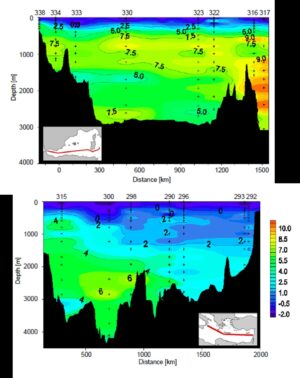We present a comprehensive account of tritium and 3He in the Mediterranean Sea since the appearance of the tritium generated by the atmospheric nuclear-weapon testing in the 1950s and early 1960s, based on essentially all available observations. Tritium in surface waters rose to 20 – 30 TU in 1964 (TU = 1018 * [3H]/[H]), a factor of about 100 above the natural level, and thereafter declined 30-fold up to 2011. The decline was largely due to radioactive tritium decay, which produced significant amounts of its stable daughter 3He. We present the scheme by which we separate the tritiugenic part of 3He and the part due to release from the sea floor (terrigenic part). We show that the tritiugenic component can be quantified throughout the Mediterranean waters, typically to a ± 0.15 TU equivalent, mostly because the terrigenic part is low in 3He. This fact makes the Mediterranean unique in offering a potential for the use of tritiugenic 3He as a tracer. The transient distributions of the two tracers are illustrated by a number of sections spanning the entire sea and relevant features of their distributions are noted. By 2011, the 3He concentrations in the top few hundred meters had become low, in response to the decreasing tritium concentrations combined with a flushing out by the general westward drift of these waters

Tritium-3He ages in Levantine Intermediate Water (LIW) were obtained repeated in time at different locations, defining transit times from the LIW source region east of Rhodes. The transit time dispersion revealed by this new application of tritium-3He dating is considerable. We find mean transit times of 12 ± 2 years up to the Strait of Sicily, 18 ± 3 years up to the Tyrrhenian Sea, and 22 ± 4 years up into the Western Mediterranean.
Authors : Wolfgang Roether, Philippe Jean-Baptiste, Elise Fourré, Jürgen Sültenfuß


